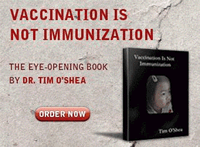CDC Halts Use of Nasal Spray Flu Vaccine
Just days ago, an advisory committee of the US Centers for Disease Control and Prevention (CDC) voted against using the popular FluMist nasal spray vaccine for the upcoming flu season campaign due to its extreme ineffectiveness.
The CDC’s vaccine task force, known as the Advisory Committee on Immunization Practices (ACIP) announced that the live attenuated vaccine was only three percent effective in children ages 2 through 17. This panel of vaccine experts stated that “no protective benefit could be measured.” In the general population, overall flu vaccine effectiveness was only 49 percent. [1]
The American Academy of Pediatrics has already formally supported the recommendation to halt the use of the nasal spray flu vaccine. [2]
This vote of no confidence in the nasal spray flu vaccine comes after three seasons of inefficacy.
Widget not in any sidebars
About the Nasal Spray Flu Vaccine
The nasal spray flu vaccine, known in medical circles as live attenuated influenza vaccine (LAIV) and known by the public as FluMist, was first licensed in 2003 as a three-in-one vaccine. Since then, according to the manufacturer, 116 million doses have been distributed around the world. [3]
So far, it is the only non-injection based vaccine against influenza on the market. US Sales of the FluMist vaccine during fiscal year 2015 were $206 million, with global sales of $290 million.
Data suggests that up to one third of children who are vaccinated against the flu previously used the nasal spray version. The nasal spray vaccine was supposed to supply eight percent of the US total expected flu vaccine doses in the coming flu season.
A History of Lack of Efficacy
Data from the CDC shows that in previous flu seasons, the nasal spray flu vaccine has been ineffective at preventing the flu in children. During the 2013-14 flu season, it showed “no measurable effectiveness.” During the 2014-2015 flu season, it showed that “neither vaccine worked well” against the flu in children ages two through eight. [4]
Even more shockingly, the CDC admits on its own website that flu vaccines are ineffective in preventing the flu in children. “Since CDC began measuring vaccine effectiveness in 2004-2005, estimates [of effectiveness] have ranged from 10% to 60%.”
AstraZeneca, the manufacturer of FluMist, disputed the CDC’s findings, yet they only claimed a 48-56 percent effectiveness using their nasal spray vaccine against influenza during the most recent flu season.
 This live vaccine also carries the ability to “shed” the flu virus from someone who has received the nasal spray vaccine to another individual. A study was conducted among children in a daycare setting, and the likelihood of acquiring a flu virus from a child who had received the nasal spray vaccine was estimated to be 2.4 percent. Due to shedding concerns, these nasal spray flu vaccines could have theoretically caused more cases of the flu than they actually prevented. [5]
This live vaccine also carries the ability to “shed” the flu virus from someone who has received the nasal spray vaccine to another individual. A study was conducted among children in a daycare setting, and the likelihood of acquiring a flu virus from a child who had received the nasal spray vaccine was estimated to be 2.4 percent. Due to shedding concerns, these nasal spray flu vaccines could have theoretically caused more cases of the flu than they actually prevented. [5]
Dr. Margot Savoy, a member of the American Academy of Family Physicians, cautioned fellow physicians, “You should not use the LAIV you preordered for anyone (adults or children) … This vote leaves no room for using LAIV in any population.” [6]
A search of the Vaccine Adverse Event Reporting System (VAERS) shows that 2,893 total adverse events have been reported with use of the FluMist live attenuated influenza vaccine. [7]
Ironically, in their press release, the CDC stated, “Today’s ACIP vote highlights the importance of measuring and evaluating the effectiveness of public health interventions.”
Conclusion
Finally, after years of data cannot hide the lack of efficacy, even government and professional organizations are taking note: flu vaccines don’t work.
Informed parents know there are safer and more effective ways to keep their children healthy, without injecting their sons and daughters with vaccines and the associated toxic ingredients.
Do you vaccinate your child or yourself against the flu? How do you promote good health in your family during the winter months? Please share your comments below and share the important information in this article with others!
References:
- http://www.cdc.gov/media/releases/2016/s0622-laiv-flu.html
- http://www.aappublications.org/news/2016/06/22/InfluenzaVaccine…
- https://www.astrazeneca.com/media-centre/press-releases/2016…
- http://www.cdc.gov/media/releases/2015/s0226-acip.html
- http://www.fda.gov/downloads…ApprovedProducts/UCM294307.pdf
- http://www.aafp.org/news/health-of-the-public/20160623laivvote.html
- https://vaers.hhs.gov/data/data
Missy Fluegge writes for VacTruth.com, where this article first appeared.



